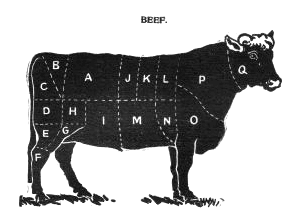Mary Cannon’s recipe for beef cheek
Sort of. Typical of its time, the original early eighteenth century recipe from Mary Cannon’s Commonplace Book offers only incomplete guidance to the cook on the assumption that she was versed enough in her craft to overcome omissions. While the narrative calls for exact amounts of anchovy, water and wine, it provides no measurement for the beef and its other ingredients. The concept itself is grand, a typically British marriage of beef, the anchovy, shallot and mace, so we have established proportions based on typical stews with an atypical if authentically robust amount of seasoning. A lost dish worthy of revival and renown. Six servings.
 4 lb beef cheek (or chuck or shin)
4 lb beef cheek (or chuck or shin)- 3 chopped anchovies or 2 teaspoons anchovy paste
- 2 or 3 blades of mace ( see the notes)
- 6 peeled and chopped shallots
- 2 cups beef stock
- 3 cups red wine
- heaped teaspoon dried thyme
- salt (not much) and pepper (lots)
- about a cup of chopped fresh green herbs
- 3 thickish slices good white bread, torn to bits
- 6 or more slices of toast
Preheat the oven to 275˚.
- Dump everything but the fresh herbs and bread into a heavy pot, line it with a round of parchment and cover it. Bake the stew until the cheeks are extremely tender, usually in from 4 to 4½ hours.
- Remove the stew from the oven, uncover the pot and stir in the herbs and bread. Simmer the stew until the bread dissolves to thicken it.
- Remove the mace and serve the stew with the toast.
Notes:
-Beef cheeks are hard to find but worth some effort. While chuck or shin is fine, the cheeks are special.
-Go easy on the salt because of the pungent anchovy.
-A blade of mace is the lattice that surrounds a nutmeg. Blades are available online from Penzey’s. You might substitute a heaped half teaspoon of ground mace for the blades but the effect is different.
-Some people find the taste of mace, which, however, is most characteristic of eighteenth century British savory foods, too strong. Nutmeg is the milder alternative.
-The original recipe:
“To Stew a Beefe’s Cheek
Bone ye Cheeks and save ye Bones to stew. Putt to them eight Quarts of water, some hole pepper, some long Mace, some Shallots, three Anchoveys, a pint of Clarett and some Salt according to your taste. Sett it over a ffire and, when it is half Stewd, add to it a good store of sweet Herbs, then stew it till it be enough. Putt in two loafes of French Bread, cut in thin Slices, stewing it a little Longer. Take it up, then putt your Cheeks in ye middle of ye Dishe and pour your Broth around them, with Sippetts round ye Dishe.”
-To add even more depth of flavor you could brown the beef in some neutral oil over high heat before step one; you could do the same with the shallots in the residual fat.
-You also may change the proportion of stock and wine to suit your taste or use what you have on hand.
-Worcestershire did not exist when Mrs. Cannon wrote her manuscript but a healthy dose of it would do no harm to her braise of beef cheek.
